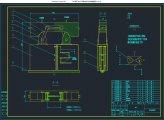港口轨行设备的风力防爬装置设计(含CAD图)

港口轨行设备的风力防爬装置设计(含CAD图)(任务书,开题报告,外文翻译,论文说明书12000字,CAD图1张)
摘 要
港口轨行设备的风力防爬装置是港口机械保证其安全性的重要辅助装置之一。现有的风力防爬装置大都采用电力或者液压控制,当起重机突遇大风断电无法提供足够大的驱动力或不能及时的感知风速的变化时不能对起重机起到良好的制动作用,故在此提出一种新型的风力防爬装置设计方案。
该方案所设计的防风器以风载荷作为原动力而产生制动力,利用杠杆原理将起重机所受风载荷放大、转化为制动力,既保证了该装置的制动能力同时又改变了现有的制动器设计机制,使该装置安全可靠、操作简单、反应迅速;不仅将原有电力提供制动力的方案改变为“化被动为主动”的利用风力来转化为制动力的方案,节约了能源,提高了经济性,而且该装置具有灵活的设计方案,可以满足在不同类型起重机和不同最大风载荷作用下的防风制动效果,且便于在不同风载作用改变工作状态,具有很强的实用性和适用范围。
本文主要介绍了该风力防风装置的工作原理、结构形式及传动方式,同时以实例计算的方式详细介绍了该装置的结构与功能,进行了可行性分析和防风制动性能分析,验证了该设计方案的可行性。
关键词:风力自锁;杠杆原理;夹轨装置;阵风防御
Abstract
The wind anti-climbing device of the port rail equipment is one of the important auxiliary devices for the safety of the port machinery. most of the wind climbing device is controlled by electrical or hydraulic, The crane can’t be properly braking when the crane which suddenly encountered a large wind power is unable to provide sufficient driving force or to detect the change of wind speed in a timely manner. So in this dissertation, a new type of wind anti - climbing device design is proposed.
The wind anti-climbing device designed by the scheme uses the wind load as the driving force to generate the braking force and the wind load of the crane is amplified and converted into the braking force by the lever principle, which not only ensures the braking ability of the device, but also changes the existing brake design mechanism, so that the device is safe and reliable, simple operation, rapid response; Not only the original scheme which provide the braking force by electrical is changed to the new scheme that proactive Convert wind force to braking force, Saving energy and improving economy, and the device has a flexible design which can meet the different types of cranes and different maximum wind load under the action of wind braking effect, it have a strong The practicality and scope of application because its working conditions in different wind load can easily be changed.
[资料来源:http://www.doc163.com]
In this dissertation, the working principle, structure and transmission mode of the windproof wind anti-climbing device are introduced. At the same time, the structure and function of the device are described in detail. The feasibility analysis and windbreak braking performance analysis are carried out to verify the design the feasibility of the program.
Keywords: Wind self-locking;Lever principle;Rail clamping device;Gust defense.
[资料来源:http://www.doc163.com]




目录
摘 要 I
Abstract II [版权所有:http://DOC163.com]
第1章绪论 1
1.1课题研究的背景 1
1.2课题研究的目的及意义 2
1.3国内外研究现状 3
1.3.1现有的防风抗滑装置 3
1.3.2国内外风载荷的研究 3
1.3.3国内外防风抗滑装置的改进与创新 4
1.3.4本文的研究内容与创新 5
第2章新型风力防风装置的一般结构 7
2.1风力防风装置结构简介 7
2.2工作原理分析 8
2.3状态分析 9
2.3.1工作或停车状态 9
2.3.2起动或运行状态 9
2.4夹轨器的设计 10
2.4.1夹轨器的原理及现有夹轨器的不足 10
2.4.2风力防风装置夹轨器的设计 10
2.5复合杠杆机构的设计 11
2.6本章小结 12
第3章力学分析 13
3.1风力防风装置整体受力 13 [资料来源:www.doc163.com]
3.2风力防风装置各结构受力分析 13
3.2.1工作结构受力分析 13
3.2.2夹轨机构受力分析 17
3.3本章小结 18
第4章结构尺寸实例计算 19
4.1选择起重机 19
4.2风载荷计算 21
4.3由可行性设计尺寸 22
4.3.1理论制动力分析 22
4.3.2基于实际的制动力分析 23
4.4主要尺寸计算 24
4.4.1工作结构尺寸 24
4.4.2夹轨结构尺寸 25
4.4.3力换向结构尺寸设计 25
4.4.4复合杠杆结构尺寸设计 26
4.5本章小结 26
第5章环境影响及经济性分析 27
5.1环境影响分析 27
5.2经济性分析 27
第6章总结与展望 28
6.1研究成果总结 28
6.2研究展望 28
参考文献 29
致谢 30 [资料来源:Doc163.com]
